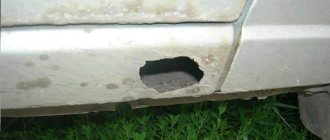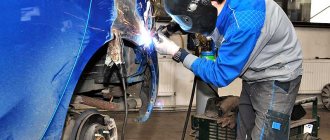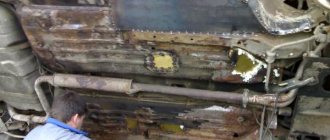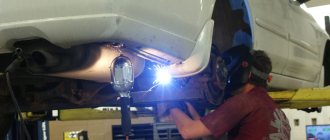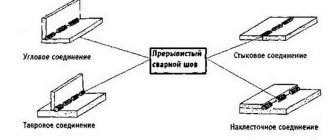11.07.2019
| (Votes: 1, Rating: 1) |
Issues discussed in the material:
- What are the classic methods for repairing dents on a car doorstep?
- How to remove a dent on a car doorstep without welding or painting
- How much does it cost to repair a dent on a car door?
The threshold is the element of the car that is most susceptible to external mechanical influence. Since the condition of roads in Russia is not very good, dents on car sills have become a common problem for car enthusiasts.
Repairing car dents in auto repair shops
Nowadays, to eliminate such damage to the body, a device called a spotter, as well as other pulling devices, are used. In order to remove a dent on a car doorstep, the damaged area is cleaned from paint to metal. Next, using a spotter, several pulling elements are welded to the threshold. And at the end of the process, the dents are gradually drawn out, and, if required, the protruding places in the area of deformation are tapped.
The sequence of actions when pulling the threshold is determined by the type of damage. If the threshold flange is damaged, it is corrected first. This element is located at the very bottom of the threshold, at the junction with the bottom. The next step is to straighten the corners of the threshold if there are dents on them. From what is described above it is clear that first of all the threshold is returned to its original shape and only then the remaining irregularities are eliminated.
You can also pull out a dent on a car threshold using a welding machine:
- If you have a semi-automatic welding machine, but do not have a spotter, then a reverse hammer can also be used for straightening. You can make it yourself or buy it in a store.
- There is another way to straighten dents without using pulling devices. Its essence lies in the fact that the dent is cut with a cross (see the figure below) and each resulting segment is installed in place, for example, using a regular screwdriver. Then all the cut places are welded.
- You can also use a chain attached to the floor to straighten the threshold. Metal loops or plates with loops are welded to the place of deformation, which are connected by a chain to the floor (or other element) of the box, and the machine is lifted with a jack. During the lifting process, the dent is gradually straightened out. This method is good for eliminating deformation of the threshold flange, which is very rigid and difficult to straighten.
- If it is impossible to secure the chain to the lower elements of the box, then you should follow the same steps as in the previous paragraph, but insert a long lever (pipe or crowbar) into the chain.
One side of it should rest against a rigid part of the car’s underbody (spar), under which a block of the required thickness should be placed. The other gradually moves down. This way the lower part of the threshold is straightened. The side dent in the threshold can be straightened in the same way, but you need to find a side stop for the lever. For example, a block of the required length is passed under the machine, one side rests against the wall of the box, and the other side serves as a stop for the lever. - Since welding is used during the work, the inside of the threshold must be treated with an anti-corrosion agent. For these purposes, special technological holes are provided, closed with rubber plugs. As an option, you can use epoxy primer, which usually includes a tube with a nozzle that sprays 360 degrees. If you neglect this point, the metal will begin to rust from the inside.
- Treating the front part of the threshold with epoxy primer before puttying will provide increased protection against corrosion.
- Next, the threshold is puttied, leveled by sanding and primed with acrylic primer, and then prepared for painting and painted.
We recommend
“How to protect car sills: a few simple methods” Read more
What are the defects?
According to the nature of their origin, all defects are classified as natural, mechanical. In the first category:
- erasing the coating from corrosion, paint;
- the appearance of rust from exposure to external factors;
- metal wear.
Mechanical damage means:
- dents after hitting an obstacle, from impacts with gravel;
- factory defects in paintwork, lack of corrosion protection.
The repair procedure is selected depending on the degree of damage; if corrosion has covered more than 70%, the part is completely replaced. In case of deformation, if the metal does not require cutting, it is enough to straighten it. If the outer layer of anti-corrosion is damaged without damaging the outer and inner parts of the metal, then clean it and apply protection.
Typically, drivers have to repair a part after hitting an obstacle; you can straighten the threshold on a car with your own hands if there is no internal wear of the metal.
How much does it cost to repair a car sill dent: price issue
It is better to entrust the removal of a dent on the threshold to service station technicians who know everything about how to remove a dent on the threshold of a car. The accumulated knowledge allows them to cope with this task, and they have all the necessary tools at hand. The service station creates all the conditions for performing work at a high level, but the cost of such services is very high.
Car owners who are not willing to pay this price can find more economical options. For example, you can contact a specialist who knows how to remove a dent on a car door sill. But such a specialist does not give any guarantees, and his garage does not always have the tools necessary for repairs.
Maximum savings can be achieved by eliminating the defect yourself. This is an excellent option for those who have already taken part in similar work and who have all the necessary tools and a suitable room for work.
But it is still better to carry out repairs from specialists. If you need to correct the geometry of the thresholds, you will need to perform several steps:
- Find a company that provides similar services.
- Discuss the price and terms of cooperation with the administrator.
- Arrive at the appointed place or call a specialist to your place.
- Provide your vehicle to perform the work.
- Wait patiently for the work to finish.
- Evaluate the result obtained.
- Make a settlement with the master.
The price for such types of work varies greatly. It all depends on the following features:
- How deep is the dent?
- So many defects.
- Difficulty of work.
- What devices and tools are used.
- Do I need to paint my car?
- Straightening method.
- What material are the spare parts made of?
- Car model.
- In what time frame must the work be completed?
- Prestige of the company.
Prices (approximate) for stretching thresholds depending on the size of the defect are given below:
- A dent of no more than 3 cm - within 900 rubles.
- From 5 to 8 cm – 1,100–1,500 rubles.
- From 10 to 15 cm – 2,500–3,500 rubles.
- From 20 to 30 cm – 4,500–5,500 rubles.
- More than 30 cm – from 6,500 rubles.
The cost of straightening one threshold without painting is approximately 4,000 rubles. With painting, the same work will cost 8,000–9,000 rubles. If it is necessary to remove a spare part, it will cost another 500 rubles.
We recommend
“Restoring a car after an accident: stages, choosing a service station, nuances” Read more
How to fix a dent on a car doorstep using a reverse hammer
The use of a reverse hammer when leveling dents in a car threshold is advisable in cases where it is difficult to get to the place of damage or the part cannot be removed. Such repairs usually cannot be done without painting. To remove a dent, you must follow these steps:
- Clean, dry and degrease the area to be restored. Remove traces of corrosion.
- Attach a reverse hammer to the center of the damage. For this, a special suction cup or applicator is used.
- By intensifying blows of the weight on the handle of the hammer, straightening is carried out
- After restoring the outside of the body, the hammer is disconnected.
It makes sense to use an applicator or suction cup only for minor damage. Deeper and more complex dents are eliminated by welding a hammer to the surface or a hook to the technological holes with special hooks.
We recommend
“Stages of engine diagnostics: what determines the sequence of work” Read more
Other options for repairing dents in car sills without welding
In some cases, when pulling out dents on thresholds without painting, instead of rings and pins, you can use a vacuum suction cup. The required vacuum is created in it by a vacuum pump. But its use is not always possible, since the shape of the dent may be such that the device will not hold securely.
The bracket with suction cups and guide rod is also used for pulling out dents on thresholds without painting. The rod in the center of the dent is fixed at its base using special glue. It serves as the base on which the bracket is installed, and is connected to the edge of the bend with suction cups. Leveling out dents in the car threshold occurs by twisting the rod. Dismantling after straightening is completed is carried out using a special adhesive solvent that does not damage the paintwork of the threshold. Next, the rod is installed at another point, and the work is performed using the same technology.
Pulling out dents on car sills without painting is not always possible due to a number of reasons. The listed methods allow you not to resort to painting only in cases where the paintwork is not damaged. Undoubtedly, this approach saves time and money. So before you resort to welding, consider these methods for fixing dents on car door sills.
We recommend
“Restoring a car after an accident: stages, choosing a service station, nuances” Read more
Work technology
The rivet connection method is the fastening of two or more metal sheets using cylindrical rods with heads at the ends. Holes are pre-drilled in the parts to be joined. A rivet, with one head made in advance, is inserted into the hole and the second head is formed. The heads of the rivets pull the sheets together and prevent them from being torn off. The rod of this fastener prevents the lateral mutual displacement of parts and is subject to shearing forces.
Rivet joints are used in body production:
- for securing sheets (of light alloys most often);
- for securing parts made of plastic materials;
- when assembling frames.
During repairs, this method is most often used to replace corroded body cladding when welding is unreliable. Riveted joints are especially common when repairing floors - the damaged area is replaced with a new panel. A properly executed rivet seam is as strong as a welded seam.
What to do if the dent on the car sill is too deep
If the damage is so complex that none of the above methods can be used, then all that remains is to cut out the entire threshold. To do this, the car doors and the floor covering under the seats are completely removed. After this, you can try to straighten the removed part by straightening it on a workbench, as is the case with removable thresholds, or install a new part to replace the old one.
Whatever method you choose to remove dents, never forget to treat the parts with anti-corrosion substances. Thresholds are very susceptible to rust.
By installing a new threshold without anti-corrosion treatment, you risk encountering the same problem again in the next few years, since moisture will quickly penetrate into the smallest cracks and lead to the formation of rust.
To paint the threshold, you need to choose the shade that is most compatible with the old paint. The same thing with varnish.
Minor body defects (chips, scratches, dents) of your car can be repaired with your own hands.
It is possible to restore those parts that have never been damaged and, accordingly, have not previously been repaired. If cracked paint, breaks and kinks are visible, then repairs cannot be completed without painting.
We recommend
“Hydraulic engine mount: features and advantages” Read more
Application of fiberglass and glue
For moderate damage, the method of sealing holes with fiberglass is often used. When this area has been processed and cleared of layers of paint and rust, it is necessary to cut several overlays from fiberglass, the size of the hole plus 2 centimeters. This area should be pre-primed and allowed to harden.
Auto repair kit
An overlay is applied to the dry surface and secured with a mixture (polyester or epoxy resin + glue). The next “part” is applied and also fixed. Thus, all the fiberglass parts are glued, placing them one on top of the other. To prevent them from sagging or deforming, you should put a lining. When the resin and glue have dried, you need to treat the work area and paint it.
Fiberglass

